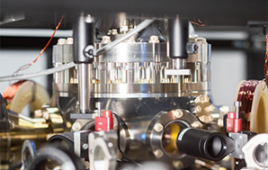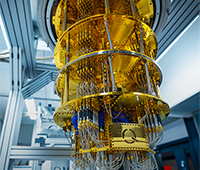 The first all-optical permanent on-chip memory has been developed by scientists of Karlsruhe Institute of Technology (KIT) and the universities of Münster, Oxford, and Exeter. This is an important step on the way toward optical computers. Phase change materials that change their optical properties depending on the arrangement of the atoms allow for the storage of several bits in a single cell. The researchers present their development in the journal Nature Photonics (10.1038/nphoton.2015.182).
The first all-optical permanent on-chip memory has been developed by scientists of Karlsruhe Institute of Technology (KIT) and the universities of Münster, Oxford, and Exeter. This is an important step on the way toward optical computers. Phase change materials that change their optical properties depending on the arrangement of the atoms allow for the storage of several bits in a single cell. The researchers present their development in the journal Nature Photonics (10.1038/nphoton.2015.182).
Light determines the future of information and communication technology: With optical elements, computers can work more rapidly and more efficiently. Optical fibers have long since been used for the transmission of data with light. But on a computer, data are still processed and stored electronically. Electronic exchange of data between processors and the memory limits the speed of modern computers. To overcome this so-called von Neumann bottleneck, it is not sufficient to optically connect memory and processor, as the optical signals have to be converted into electric signals again. Scientists, hence, look for methods to carry out calculations and data storage in a purely optical manner.
Scientists of KIT, the University of Münster, Oxford University, and Exeter University have now developed the first all-optical, non-volatile on-chip memory. “Optical bits can be written at frequencies of up to a gigahertz. This allows for extremely quick data storage by our all-photonic memory,” Professor Wolfram Pernice explains. Pernice headed a working group of the KIT Institute of Nanotechnology (INT) and recently moved to the University of Münster.
“The memory is compatible not only with conventional optical fiber data transmission, but also with latest processors,” Professor Harish Bhaskaran of Oxford University adds.
The new memory can store data for decades even when the power is removed. Its capacity to store many bits in a single cell of a billionth of a meter in size (multi-level memory) also is highly attractive. Instead of the usual information values of 0 and 1, several states can be stored in an element and even autonomous calculations can be made. This is due to so-called phase change materials, novel materials that change their optical properties depending on the arrangement of the atoms: Within shortest periods of time, they can change between crystalline (regular) and amorphous (irregular) states. For the memory, the scientists used the phase change material Ge2Sb2Te5 (GST). The change from crystalline to amorphous (storing data) and from amorphous to crystalline (erasing data) is initiated by ultrashort light pulses. For reading out the data, weak light pulses are used.
Permanent all-optical on-chip memories might considerably increase future performance of computers and reduce their energy consumption. Together with all-optical connections, they might reduce latencies. Energy-intensive conversion of optical signals into electronic signals and vice versa would no longer be required.
Citation: Carlos Ríos, Matthias Stegmaier, Peiman Hosseini, Di Wang, Torsten Scherer, C. David Wright, Harish Bhaskaran, Wolfram H.P. Pernice: On-chip integratable all-photonic nonvolatile multi-level memory. Nature Photonics. DOI: 10.1038/nphoton.2015.182



